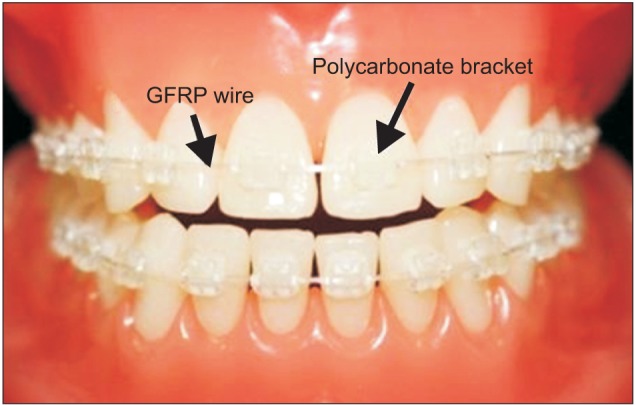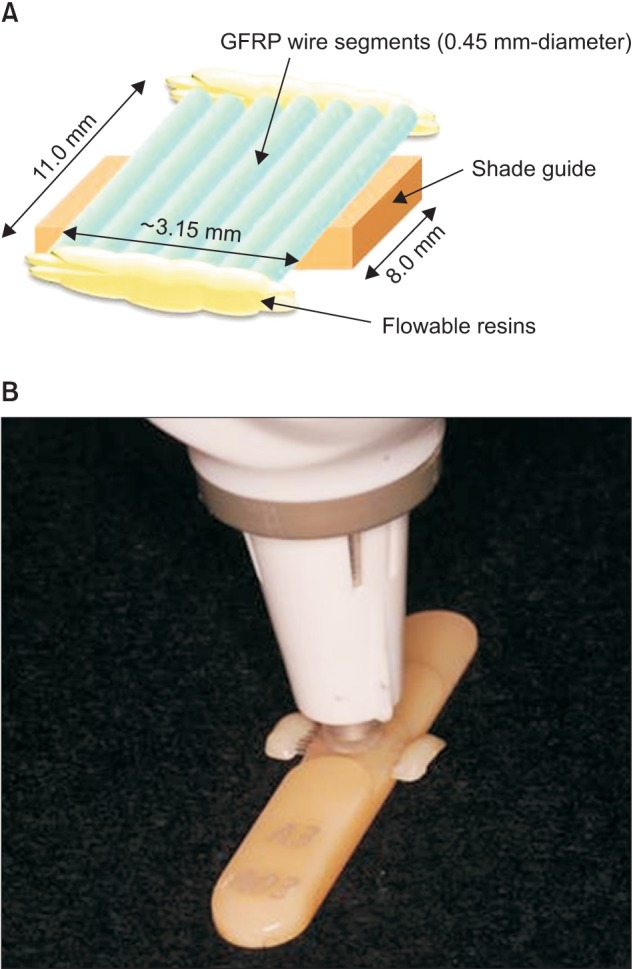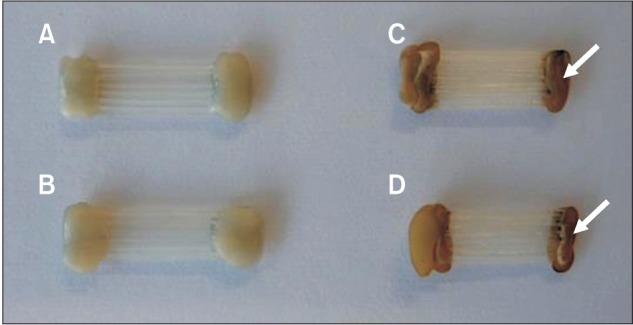Korean J Orthod.
2015 May;45(3):130-135. 10.4041/kjod.2015.45.3.130.
Color stability of laboratory glass-fiber-reinforced plastics for esthetic orthodontic wires
- Affiliations
-
- 1Department of Orthodontics, Nihon University School of Dentistry at Matsudo, Chiba, Japan.
- 2Department of Dental Biomaterials, Nihon University School of Dentistry at Matsudo, Chiba, Japan. tanimoto.yasuhiro@nihon-u.ac.jp
- KMID: 1974804
- DOI: http://doi.org/10.4041/kjod.2015.45.3.130
Abstract
OBJECTIVE
In our previous study, glass-fiber-reinforced plastics (GFRPs) made from polycarbonate and glass fibers were prepared for esthetic orthodontic wires using pultrusion. These laboratory GFRP wires are more transparent than the commercially available nickel-titanium wire; however, an investigation of the color stability of GFRP during orthodontic treatment is needed. Accordingly, in the present study, the color stability of GFRP was assessed using colorimetry.
METHODS
Preparation of GFRP esthetic round wires (diameter: 0.45 mm [0.018 inch]) using pultrusion was described previously. Here, to investigate how the diameter of fiber reinforcement affects color stability, GFRPs were prepared by incorporating either 13-microm (GFRP-13) or 7-microm glass (GFRP-7) fibers. The color changes of GFRPs after 24 h, and following 1, 2, and 4 weeks of coffee immersion at 37degrees C, were measured by colorimetry. We evaluated the color stability of GFRPs by two evaluating units: the color difference (DeltaE*) and National Bureau of Standards (NBS).
RESULTS
After immersion, both GFRPs showed almost no visible color change. According to the colorimetry measurements, the DeltaE* values of GFRP-13 and GFRP-7 were 0.73-1.16, and 0.62-1.10, respectively. In accordance with NBS units, both GFRPs showed "slight" color changes. As a result, there were no significant differences in the DeltaE* values or NBS units for GFRP-13 or GFRP-7. Moreover, for both GFRPs, no significant differences were observed in any of the immersion periods.
CONCLUSIONS
Our findings suggest that the GFRPs will maintain high color stability during orthodontic treatment, and are an attractive prospect as esthetic orthodontic wires.
Keyword
Figure
Reference
-
1. O'Brien WJ. Orthodontic wire. In : O'Brien WJ, editor. Dental materials and their selection. Chicago: Quintessence Pub Co;2008.2. Eliades T. Dental materials in orthodontics. In : Graber LW, Vanarsdall RL, Vig KWL, editors. Orthodontics: current principles and techniques. 5th ed. Philadelphia, PA: Elsevier/Mosby;2012. p. 1023–1037.3. Elayyan F, Silikas N, Bearn D. Ex vivo surface and mechanical properties of coated orthodontic archwires. Eur J Orthod. 2008; 30:661–667. PMID: 19011166.
Article4. Yu B, Lee YK. Aesthetic colour performance of plastic and ceramic brackets-an in vitro study. J Orthod. 2011; 38:167–174. PMID: 21875990.5. Lee YK. Colour and translucency of tooth-coloured orthodontic brackets. Eur J Orthod. 2008; 30:205–210. PMID: 18390838.
Article6. Eliades T, Eliades G, Brantly WA. Orthodontic brackets. In : Brantly WA, Eliades T, editors. Orthodontic materials. New York: Thieme;2001. p. 143–172.7. da Silva DL, Mattos CT, Simão RA, de Oliveira Ruellas AC. Coating stability and surface characteristics of esthetic orthodontic coated archwires. Angle Orthod. 2013; 83:994–1001. PMID: 23650959.
Article8. Zegan G, Sodor A, Munteanu C. Surface characteristics of retrieved coated and nickel-titanium orthodontic archwires. Rom J Morphol Embryol. 2012; 53:935–939. PMID: 23303016.9. Fujihara K, Teo K, Gopal R, Loh PL, Ganesh VK, Ramakrishna S, et al. Fibrous composite materials in dentistry and orthopaedics: Review and applications. Compos Sci Technol. 2004; 64:775–788.
Article10. Tanimoto Y, Inami T, Yamaguchi M, Nishiyama N, Kasai K. Preparation, mechanical, and in vitro properties of glass fiber-reinforced polycarbonate composites for orthodontic application. J Biomed Mater Res B Appl Biomater. 2014; doi:10.1002/jbm.b.33245 [Epub ahead of print].11. de Mendonca MR, Fabre AF, Goiatto MC, Cuoghi OA, Verri ACG. Spectrophotometric evaluation of color changes of esthetic brackets stored in potentially staining solutions. RPG Rev pós-gra. 2011; 18:20–27.12. Filho HL, Maia LH, Araújo MV, Eliast CN, Ruellas AC. Colour stability of aesthetic brackets: ceramic and plastic. Aust Orthod J. 2013; 29:13–20. PMID: 23785933.13. Faltermeier A, Behr M, Müssig D. In vitro colour stability of aesthetic brackets. Eur J Orthod. 2007; 29:354–358. PMID: 17702794.
Article14. Martins da Silva AV, de Mattos GV, Kato CM, Normando D. In vivo color changes of esthetic orthodontic ligatures. Dental Press J Orthod. 2012; 17:76–80.15. Kim SH, Lee YK. Measurement of discolouration of orthodontic elastomeric modules with a digital camera. Eur J Orthod. 2009; 31:556–562. PMID: 19474228.
Article16. da Silva DL, Mattos CT, de Araújo MV, de Oliveira Ruellas AC. Color stability and fluorescence of different orthodontic esthetic archwires. Angle Orthod. 2013; 83:127–132. PMID: 22591261.
Article17. Lee YK. Changes in the reflected and transmitted color of esthetic brackets after thermal cycling. Am J Orthod Dentofacial Orthop. 2008; 133:641.e1–641.e6. PMID: 18456136.
Article18. Yamanel K, Caglar A, Özcan M, Gulsah K, Bagis B. Assessment of color parameters of composite resin shade guides using digital imaging versus colorimeter. J Esthet Restor Dent. 2010; 22:379–388. PMID: 21126293.
Article19. Joiner A. Tooth colour: a review of the literature. J Dent. 2004; 32(Suppl 1):3–12. PMID: 14738829.
Article20. Faltermeier J, Simon P, Reicheneder C, Proff P, Faltermeier A. The influence of electron beam irradiation on colour stability and hardness of aesthetic brackets. Eur J Orthod. 2012; 34:427–431. PMID: 21502379.
Article21. Douglas RD, Steinhauer TJ, Wee AG. Intraoral determination of the tolerance of dentists for perceptibility and acceptability of shade mismatch. J Prosthet Dent. 2007; 97:200–208. PMID: 17499089.
Article22. Scabell AL, Elias CN, Fernandes DJ, Quintao CCA. Failure of fiber reinforced composite archwires. J Res Practice Dent. 2013; doi: 10.5171/2013.304484 [Epub ahead of print].
Article23. Hamanaka I, Iwamoto M, Lassila L, Vallittu P, Shimizu H, Takahashi Y. Influence of water sorption on mechanical properties of injection-molded thermoplastic denture base resins. Acta Odontol Scand. 2014; 72:859–865. PMID: 24850507.
Article24. Ardeshna AP. Clinical evaluation of fiber-reinforced-plastic bonded orthodontic retainers. Am J Orthod Dentofacial Orthop. 2011; 139:761–767. PMID: 21640882.
Article25. Shiozawa M, Takahashi H, Asakawa Y, Iwasaki N. Color stability of adhesive resin cements after immersion in coffee. Clin Oral Investig. 2014; doi: 10.1007/s00784-014-1272-8 [Epub ahead of print].
Article26. Dietschi D, Campanile G, Holz J, Meyer JM. Comparison of the color stability of ten new-generation composites: an in vitro study. Dent Mater. 1994; 10:353–362. PMID: 7498599.
Article27. Lee IB, Min SH, Kim SY, Ferracane J. Slumping tendency and rheological properties of flowable composites. Dent Mater. 2010; 26:443–448. PMID: 20170946.
Article28. Ertaş E, Güler AU, Yücel AC, Köprülü H, Güler E. Color stability of resin composites after immersion in different drinks. Dent Mater J. 2006; 25:371–376. PMID: 16916243.
- Full Text Links
- Actions
-
Cited
- CITED
-
- Close
- Share
- Similar articles
-
- An esthetic appliance for the management of crown-root fracture: a case report
- Evaluation of frictional forces between orthodontic brackets and archwires
- Comparison between fiber-reinforced polymers and stainless steel orthodontic retainers
- A Case Report on Glass Fiber-induced Health Hazard due to Car interior Material
- Comparison of the fracture resistances of glass fiber mesh- and metal mesh-reinforced maxillary complete denture under dynamic fatigue loading




